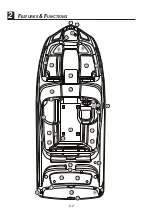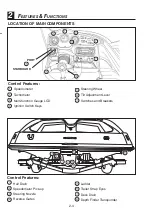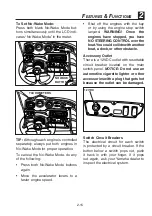
2-13
F
EATURES
&
F
UNCTIONS
2
Warning Definition Table
WARNING
LCD DISPLAY
AUDIBLE
Engine Overheating
Engine Over Temperature
Y
Engine Oil Pressure Low
Low Oil Press
Y
Check Engine
Check Engine
Y
Low Battery Voltage
Low Voltage
Y
High Battery Voltage
High Voltage
Y
ENGINE OVERHEAT
WARNING SYSTEM
This model is equipped with an engine
overheat warning system. If the engine
starts to overheat, “ENGINE OVER
TEMP” will appear on the LCD display
of the affected engine. The buzzer also
begins to sound. The engine speed is
automatically limited to help prevent
damage. If this occurs, immediately
reduce the engine speed, return to
shore or maneuver to a safe location,
and check for water discharge at the
cooling water pilot outlets.
Each engine is equipped with cooling-
water pilot outlets
on the starboard
side of the hull. The port side engine is
the one closest to the bow. Check that
water comes out of the outlet while the
engine is running, particularly while
applying throttle. If you do not see any
water at the outlet, cooling water may
not be circulating in the engine.
TIP: If water cooling passages on the
engines are dry, it will take about 20
seconds for water to reach the pilot out-
lets after starting.
If water is not circulating, something
may be clogging the jet intake grate.
Refer to the Jet Pump Clean-Out
procedures on page 5-5 for further
information.
If the cause of overheating cannot
be found and corrected, take special
precautions to avoid major engine
damage while you return to shore.
SINGLE ENGINE OVERHEATING —
Shut off the overheating engine and
use the properly running engine to
return to shore. Operate at “no wake”
speed to prevent water from flooding
the non-operating engine through
the cooling water intake. See page
2-14 for “No Wake Mode” system op-
eration.
BOTH ENGINES OVERHEATING — If
getting a tow from another vessel is
not possible, operate both engines
just slightly above idle while you
return to shore. If you can be towed,
refer to “Towing the boat” on page
5-3.
















































